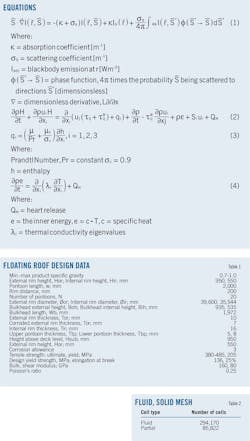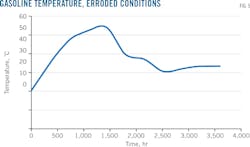Ahmed Saad Noaman
Petrojet
Cairo
External floating single-roof tanks should not be used to store gasoline in hot regions unless the deck plate's thickness exceeds 10 mm and it has been treated with an anti-corrosion coating. Solar radiation can cause large problems in storage tanks with floating roofs. The direct contact between the fluid and the floating deck raises the fluid's temperature and increases the vaporization rate of products inside the tank, both wasting product which could otherwise be sold and creating an unsafe operating environment.
This article centers on a study performed to determine the effects of July 31, 2016, solar radiation on a gasoline storage tank in Cairo, Egypt. Late July is typically the hottest time of the year in Cairo, 40° C. with 20 mph winds. The study was repeated and analyzed under corrosion conditions to determine corrosion's effect on fluid temperature.
The study used computational fluid dynamics (CFD) analysis to measure the gasoline's temperature for 1 hr and then calculate vapor losses by the charts provided in Perry's Chemical Engineering Handbook.1 Simulating solar radiation's effect on fluid temperature inside the tank during design will increase the tank's safety during operation.
Previous studies focused on if thermal stress on the floating roof could damage it.2 Strain and temperature were measured on an actual floating roof via visual fiber gauges. Thermal stress on the floating roof turned out to be too small to cause initial cracking (Fig. 1). Temperature fluctuations over the course of a day, however, could affect crack propagation.
Other researchers concentrated on heat transfer inside storage tanks.3 Some developed an estimate model for the 2D temperature field of an enormous floating roof tank and inspected solar radiation's effect on liquid temperature as related to rooftop thickness. Another study examined the intentional heating of a vertical storage tank using ANSYS Fluent and deliberated the heating equipment's influence by thermal analysis.
Examined tank
The investigated tank (Fig. 2) had a 40-m diameter, was 23 m tall, and held 700-kg/cu m density oil. The external single-deck floating roof's outside diameter measured 39.6 m. The single-deck floating roof consisted of SA283 Grade C steel with a 7,850 kg/cu m density.
Methodology
This study used Solidworks flow-simulation software. The CFD software contains turbulence models, Navier-Stokes equations, and models for physical phenomena. Simulating flow via CFD can accelerate the design stage and improve the reliability and predictability of operations.
Solidworks flow simulation is founded on two principles:
• Direct use of 3D CAD as the geometry information source.
• Grouping of full 3D CFD modelling with simpler engineering techniques in cases when the mesh resolution is insufficient for full 3D simulation.
The software uses multiple technologies to function within the CAD system:
• CAD data management.
• Mesh generator.
• Engineering modelling.
• CFD solvers.
• Results processing.
Numerical basis
The study used discrete ordinates. The 4π directional domain within the computational domain at any position is discretized into the definite number of equivalent solid angles. Equation 1 calculates radiation.4
Radiation-absorptive solids absorb and produce thermal radiation based on the coefficient of the identified solid material's absorption. While scattering is not taken into consideration, opaque solids' surfaces absorb thermal radiation based on coefficients of their specific emissivity. The rest of a radiation incident is imitated diffusively or specularly, depending on their coefficient of specified specularity.
Radiation normally is refracted according to the specified indices of refraction of the solid and adjacent medium: a transparent solid or fluid or another radiation absorptive solid, or the refraction index. The radiation spectrum consists of many bands and users specify their edges. We considered the characteristics of radiation materials, sources, and surfaces within every band, taking into account the appropriate heat fluxes in partial cells for solid cells inside the semi-transparent solid bodies or immersed fluid-solid boundaries.
Heat transfer
Heat transfer in solids and fluids with energy exchanged between them (conjugate heat transfer) is important in using any CFD software. Equation 2 (Navier-Stokes) describes heat transfer in fluids and Equation 3 heat flux. Equation 4 describes heat conduction in solid media.
Procedure
Three-dimensional modeling the floating-roof tank via CFD analysis uses multiple inputs from the field tank:
• External analysis.
• Solid heat conduction.
• Solar radiation.
• Location: Cairo, July 31, 12 pm.
• Solid absorption.
• Time duration, 1 hr (3,600 sec).
• Media; gasoline, air.
• Wall material, condition.
Creating a fluid and solid mesh for CFD analysis follows input of these data (Table 2).
CFD analysis
A decrease in deck plate thickness to 5 mm from 8 mm due to surface corrosion increased surface temperature of the stored gasoline to 54 °C. (129 °F.) from 45.6 °C. (Figs. 3-6). Gasoline vaporization totaled 7% in normal conditions (45.6 °C.) and 10% in corrosion conditions (54 °C.), an environmentally and economically problematic level for the operator. An internal floating roof would reduce evaporation and increase safety.
References
1. Perry, R.H., Maloney, J.O., and Green, D.W., "Perry's Chemical Engineers' Handbook," Knovel, Norwich, NY, 2001.
2. Hirokawa, Y., "Study on Damage of A Floating Roof-Type Oil Storage Tank Due to Thermal Stress," Applied Mechanics and Materials, Vol. 232, November 2012, pp. 803-807.
3. Zhao, Z.M., "Numerical Simulation of the Unsteady Heat Transfer Problem for the Floating Roof Oil Tank in Bei Oil Depot in Daqing," Daqing Petroleum Institute, Daqing, China, 2009.
4. Sobachkin, A., Dumnov, G., and Sobachkin, A., "Numerical Basis of CAD-Embedded CFD," Dassault Systemes, February 2014.
The author
Ahmed Saad Noaman ([email protected]) is a mechanical engineer at Petrojet, Cairo. He holds a BS (2008) and MS (2016) in mechanical engineering from Ain Shams University, Cairo.







